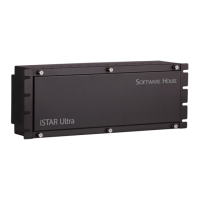Cluster Configuration
iSTAR Ultra Installation and Configuration Guide 3–5
Cluster Configuration
iSTAR Ultra controllers are organized for network communications into user-defined, logical
groups called clusters.
iSTAR controllers must belong to a user-defined group called a cluster. It is possible to have
from one to sixteen controllers in a cluster. One of the controllers is designated as the Master
and the Master acts as a relay agent to the Host for all of the controllers in the cluster.
There are two different types of clusters based on whether or not the data transfers are
encrypted or not. Encrypted clusters employ the Advanced Encryption Standard (AES)
utilizing 256 bits FIPS-197.
Encrypted clusters can contain the following controllers:
iSTAR Edge (1, 2, or 4 reader models)
iSTAR eX (4 or 8 reader models)
iSTAR Ultra (If running default Encrypted mode set by S1-1=true)
iSTAR Ultra SE (If Ultra mode (S1-4 = False) and Encrypted mode (S1-1=True)
Non-Encrypted clusters can contain the following controllers:
iSTAR Pro
iSTAR Ultra (If not running Encrypted mode set by S1-1=false)
iSTAR Ultra SE (Pro Mode) (If not running Encrypted mode set by S1-1 = False)
iSTAR Ultra SE (Ultra Mode) (If not running Encrypted mode set by S1-1 = False)
iSTAR Classic
Master and Member Configuration
Each cluster has one controller that serves as the master; any other controller in the cluster is a
cluster member. The master manages all communications between the cluster and a C•CURE
host computer.
Cluster members can communicate with each other via the master, over an Ethernet network.
Cluster members cannot communicate with each other directly. In Figure 3-3 on page 3-6, the
diagram on the left shows how cluster member A communicates with the host via the master.
The diagram on the right shows how cluster member A communicates with cluster member B
via the master.

